Ancient coins
Since the Renaissance, people have been collecting coins from ancient times. Started in the mid-18th century, the coin collection of the Imperial Academy of Turku gave Finns the first opportunity to see authentic antiquities, whereas previously they could only be seen in books. Most of the coins in the collection were donated by private individuals. Before the Great Fire of Turku in 1827, the Imperial Academy owned more than 2,000 ancient coins, and more than 1,600 were still left after the fire. However, most of these are copper coins; only 16 Greek and 181 Roman silver coins were recorded among the coins found in the ruins.
After the fire, the collection was moved to Helsinki with the university. In the 19th century, the collection was also largely increased by donations. The donors included numerous soldiers and several sea captains. A hundred years ago, museums still typically arranged their coin collections in a systematic order, often losing the information about the origins in the process. The ancient Greek silver coins presented here all come from the collections of the University of Helsinki, but it is no longer possible to say exactly in which year and from whom a particular coin was received.
Coins struck by ancient Greek cities often followed the same themes. The front face usually featured a god or hero who had a special connection to the city through its mythical history. On the back face, there was an animal or symbol associated with the god, but sometimes also a play on words relating to the name of the city or something the city was known for. Coins struck by rulers include gods, heroes or other symbols relevant to the ruler in question and, in some cases, the ruler’s own portrait. Sometimes, the successors of important kings used the symbols of these kings instead of their own to make a visible connection with their predecessor, especially if there was doubt about the transfer of power.
In ancient Greece, there were several different monetary systems, three of which were more widely used. The use of monetary systems was often influenced by alliances between city-states. The Attic system was based on the Athenian silver drachma, which weighed 4.3 g. The Corinthian system, on the other hand, was based on the silver stater, which weighed 8.6 g and was divided into three drachmas weighing 2.9 g each. The third system was Aegean and was based on the didrachma, which weighed 12.2 g, i.e. as much as two drachmas of 6.1 g. The obol was a smaller unit of currency, weighing about 0.7 g, and six obols made a drachma. The diobol was worth two obols, the tetradrachm was worth four drachmas, etc.
The exact dating of coins is often difficult, since they do not contain years and rarely bear names known from other sources.
This selection was curated by trainee Ilona Hautamaa in spring 2021.
Select an image for more information
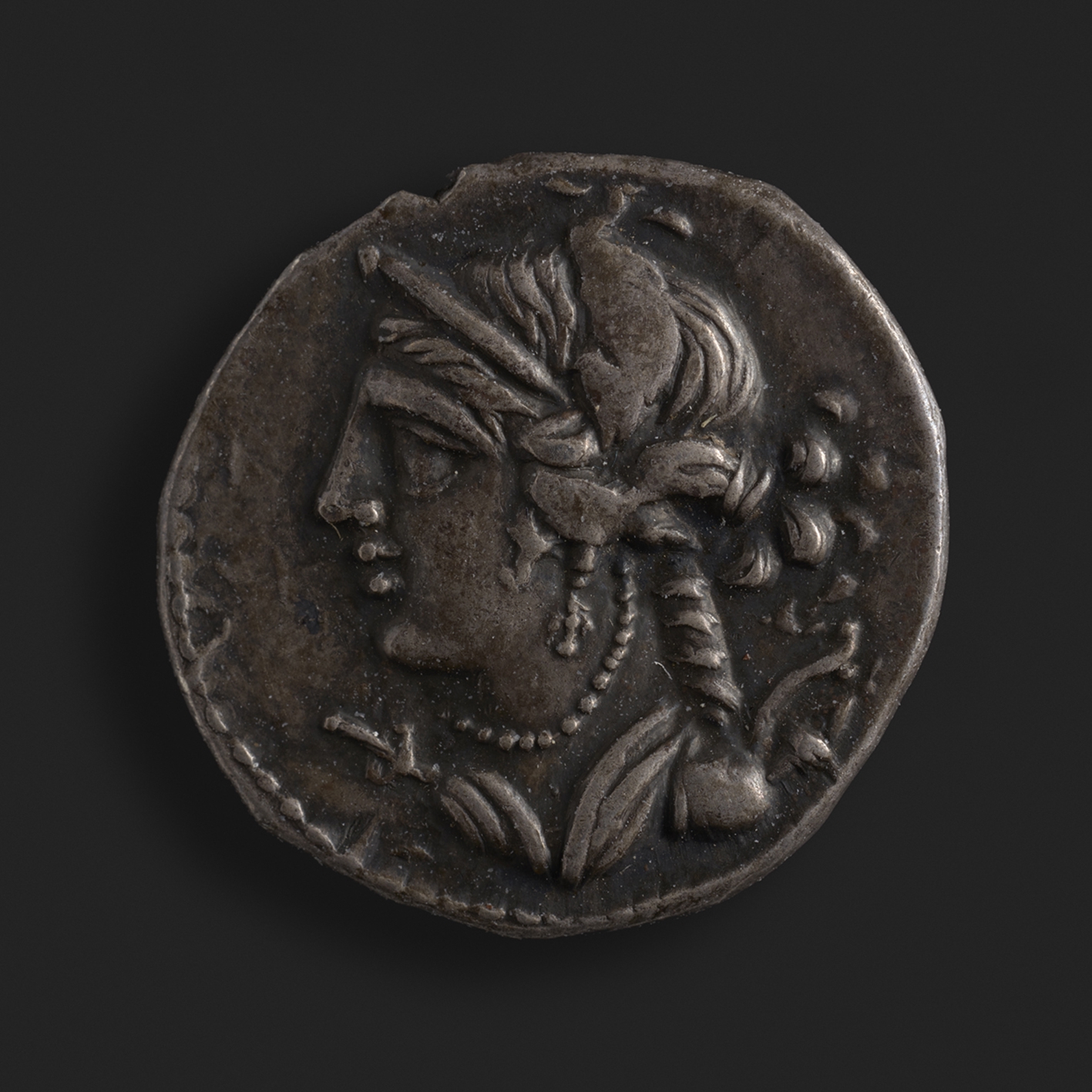
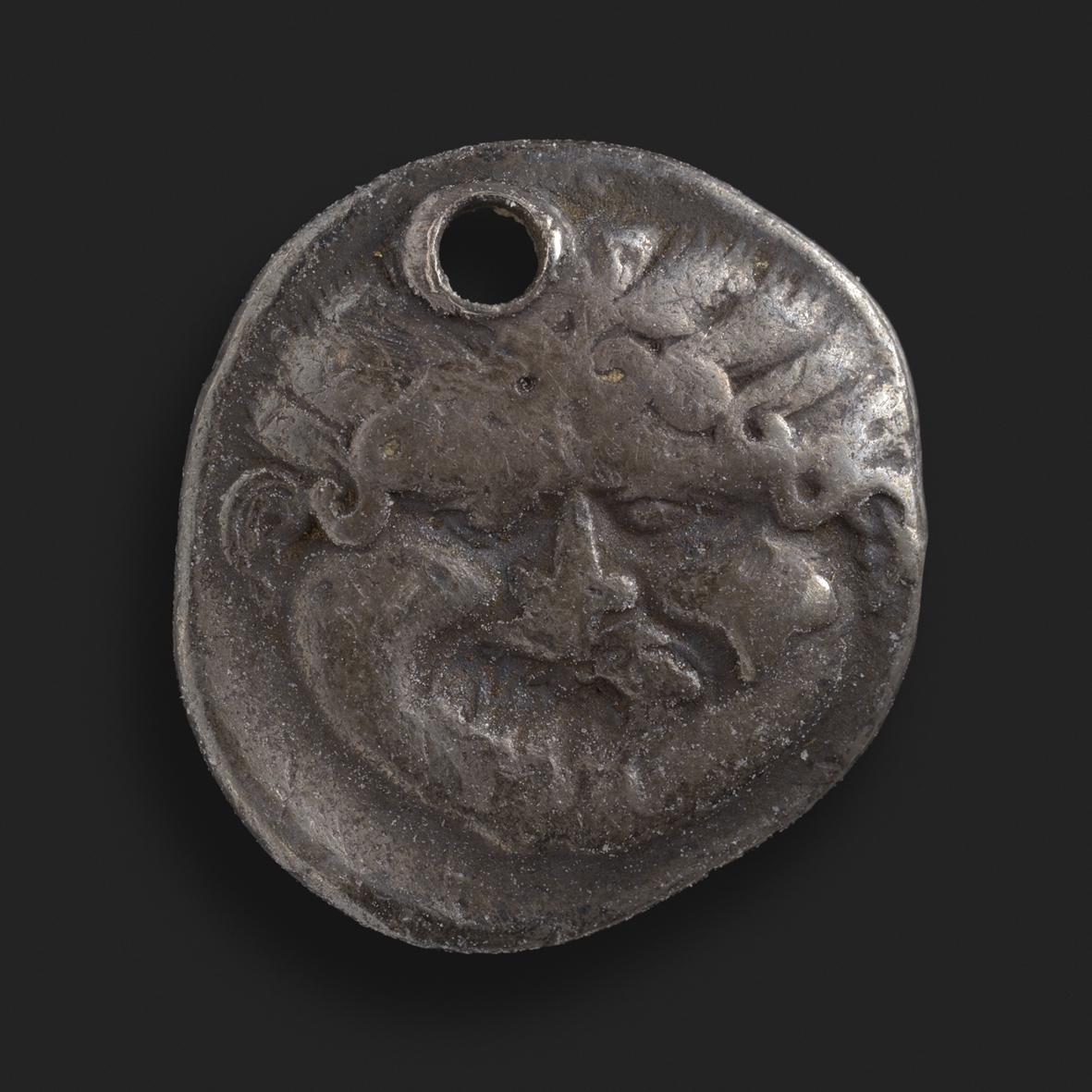
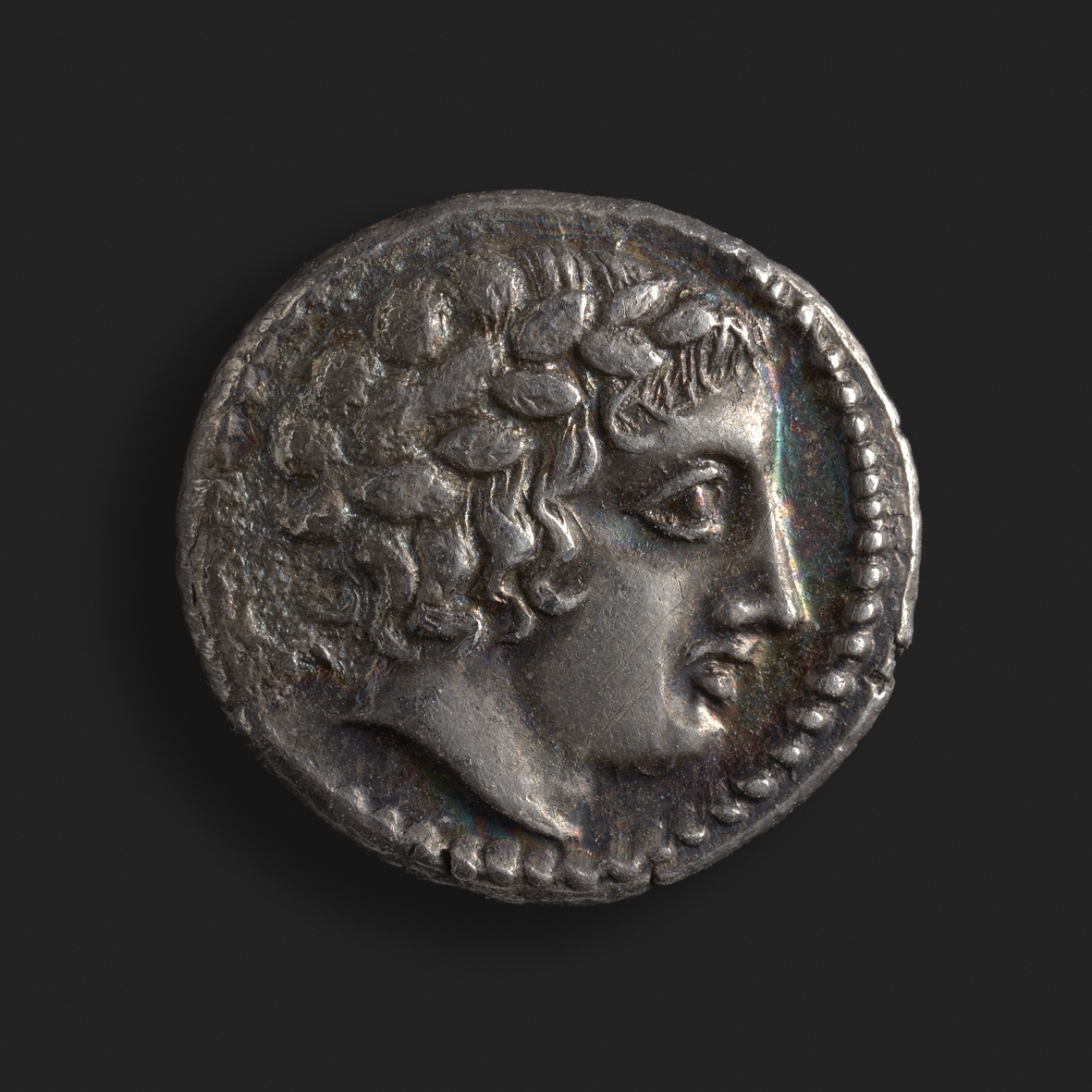
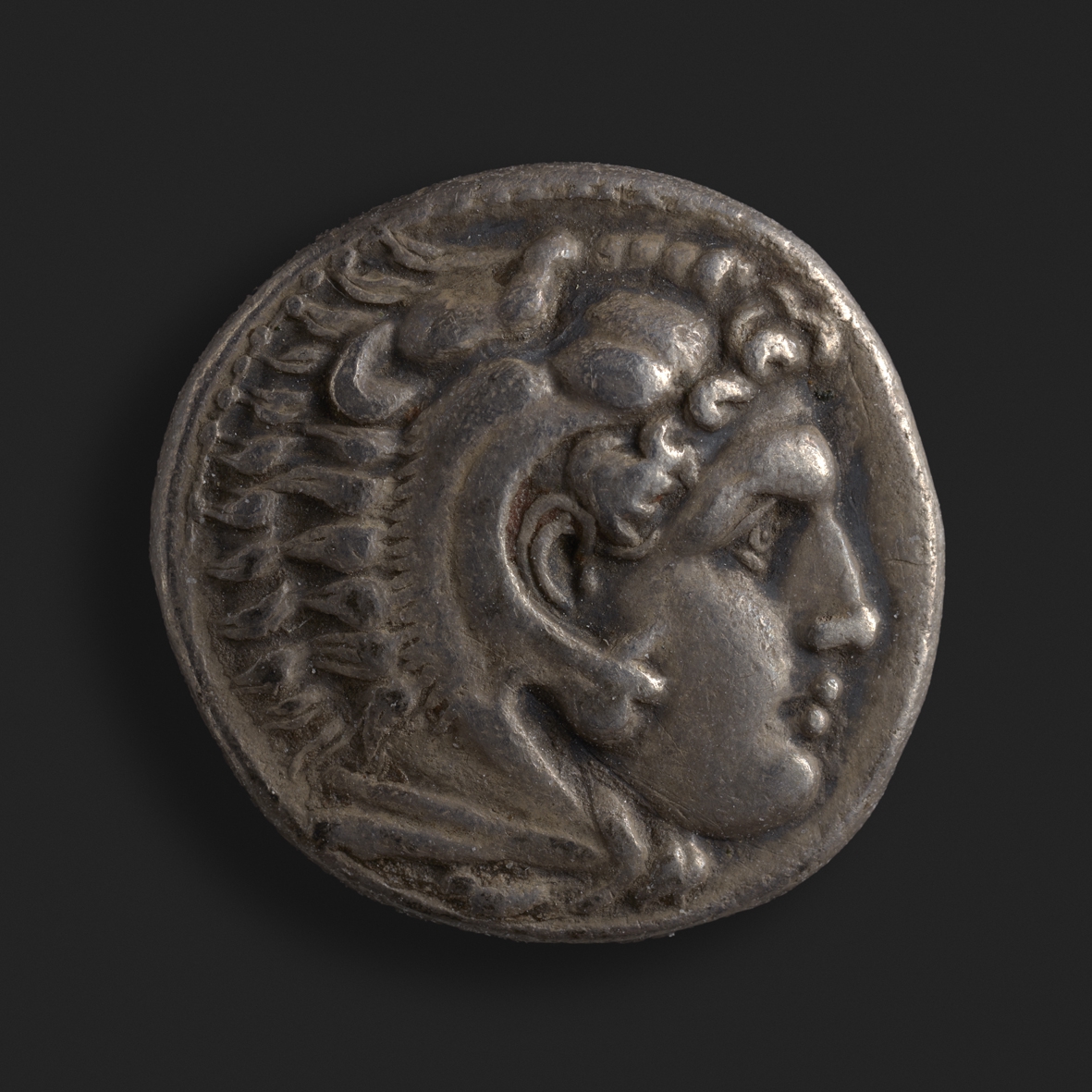
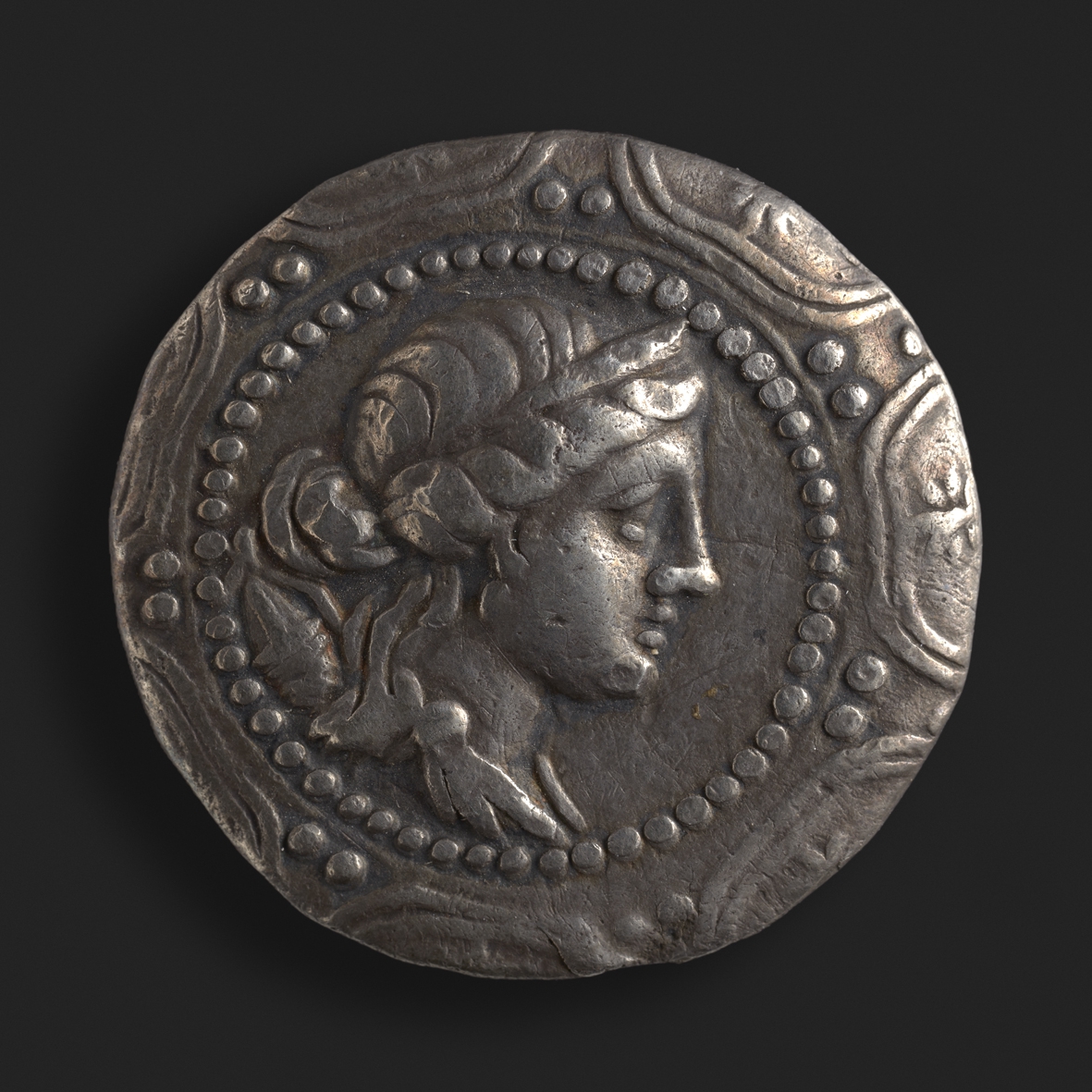
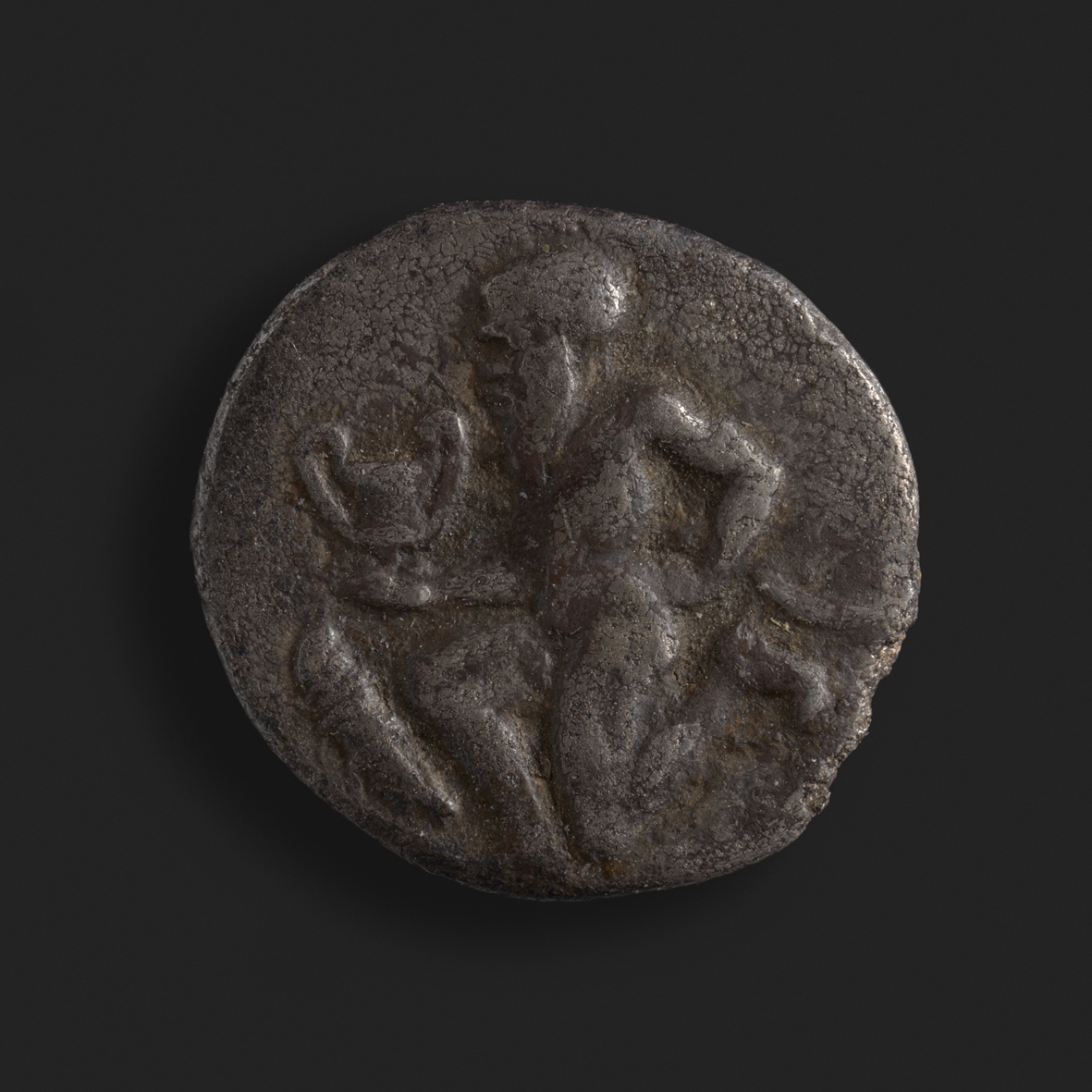

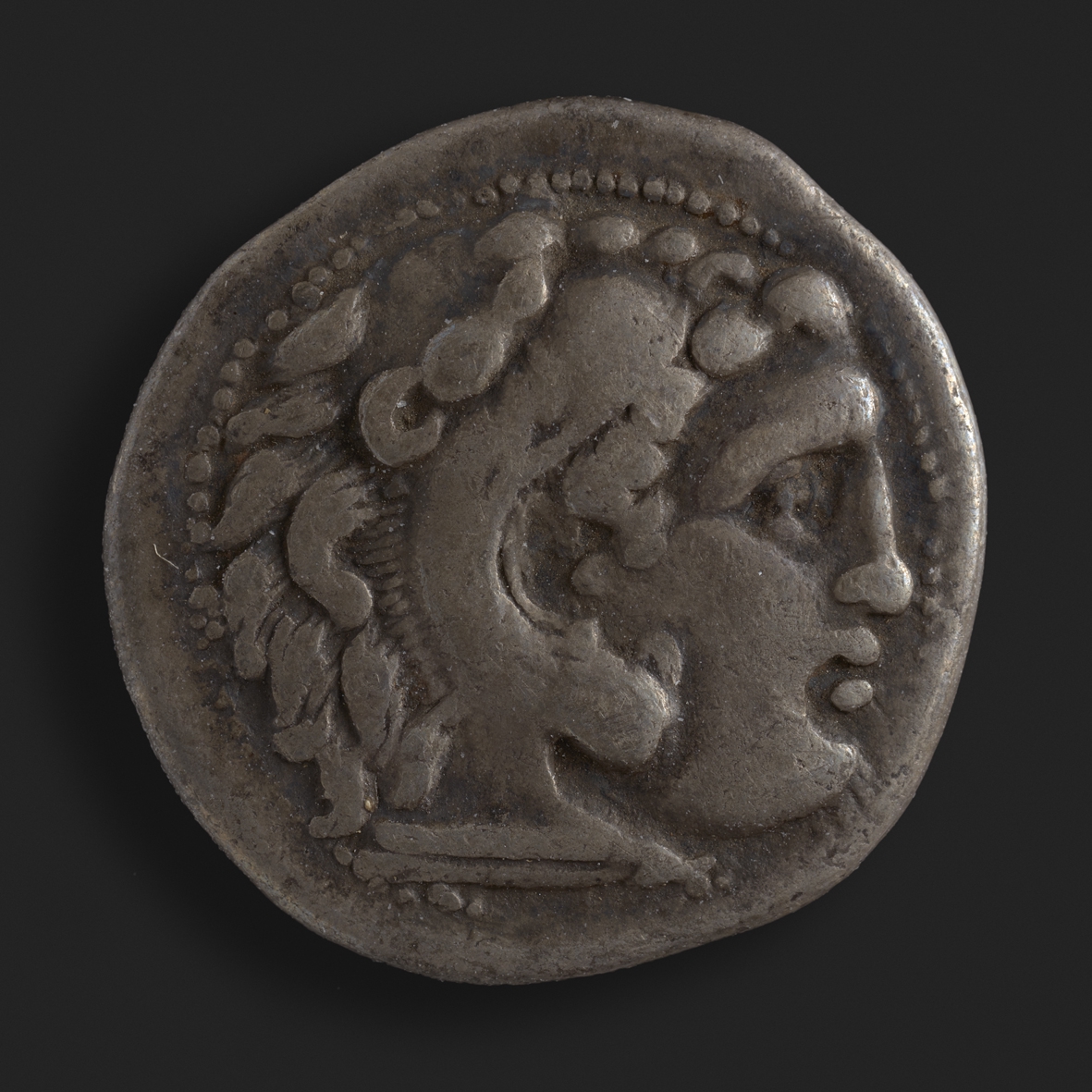
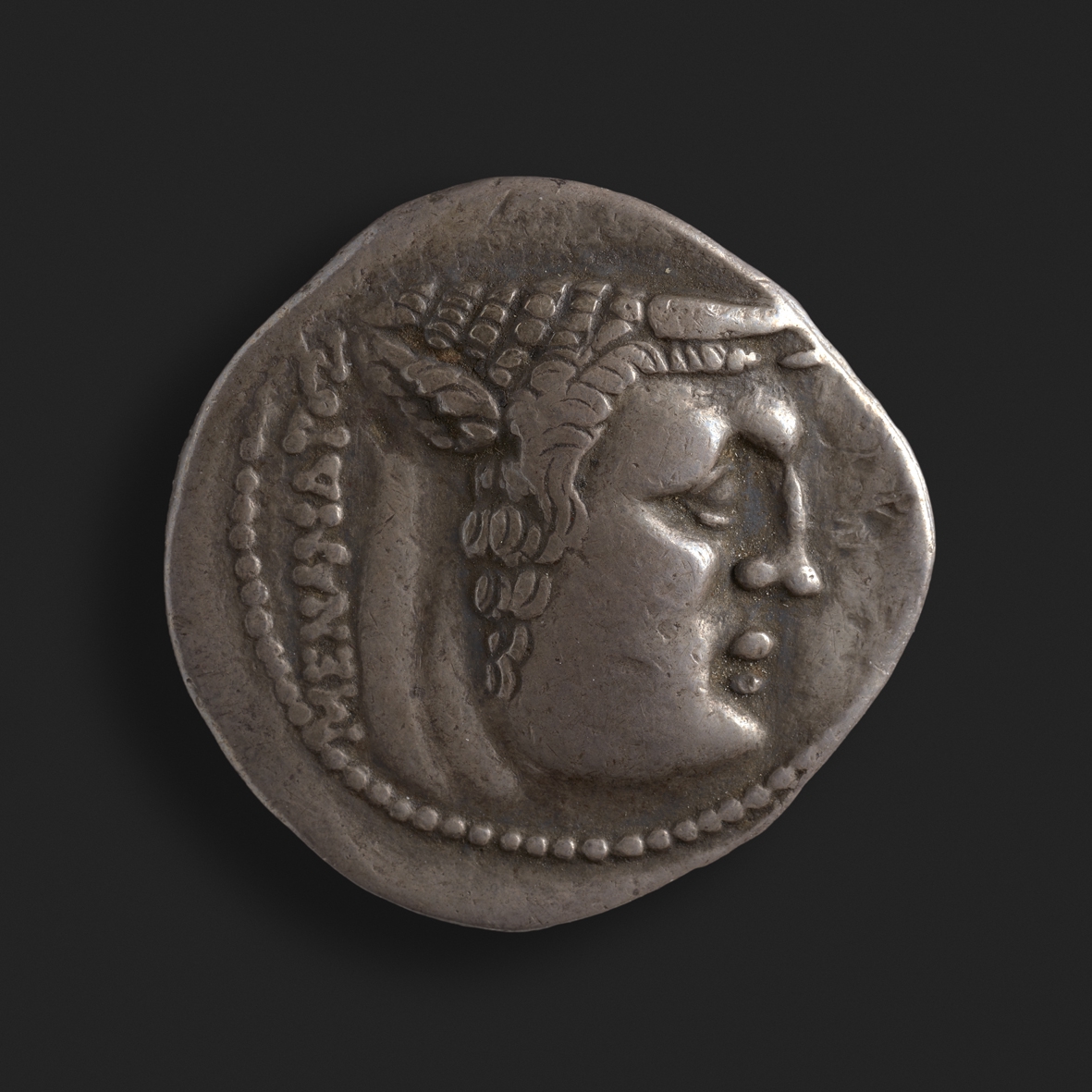
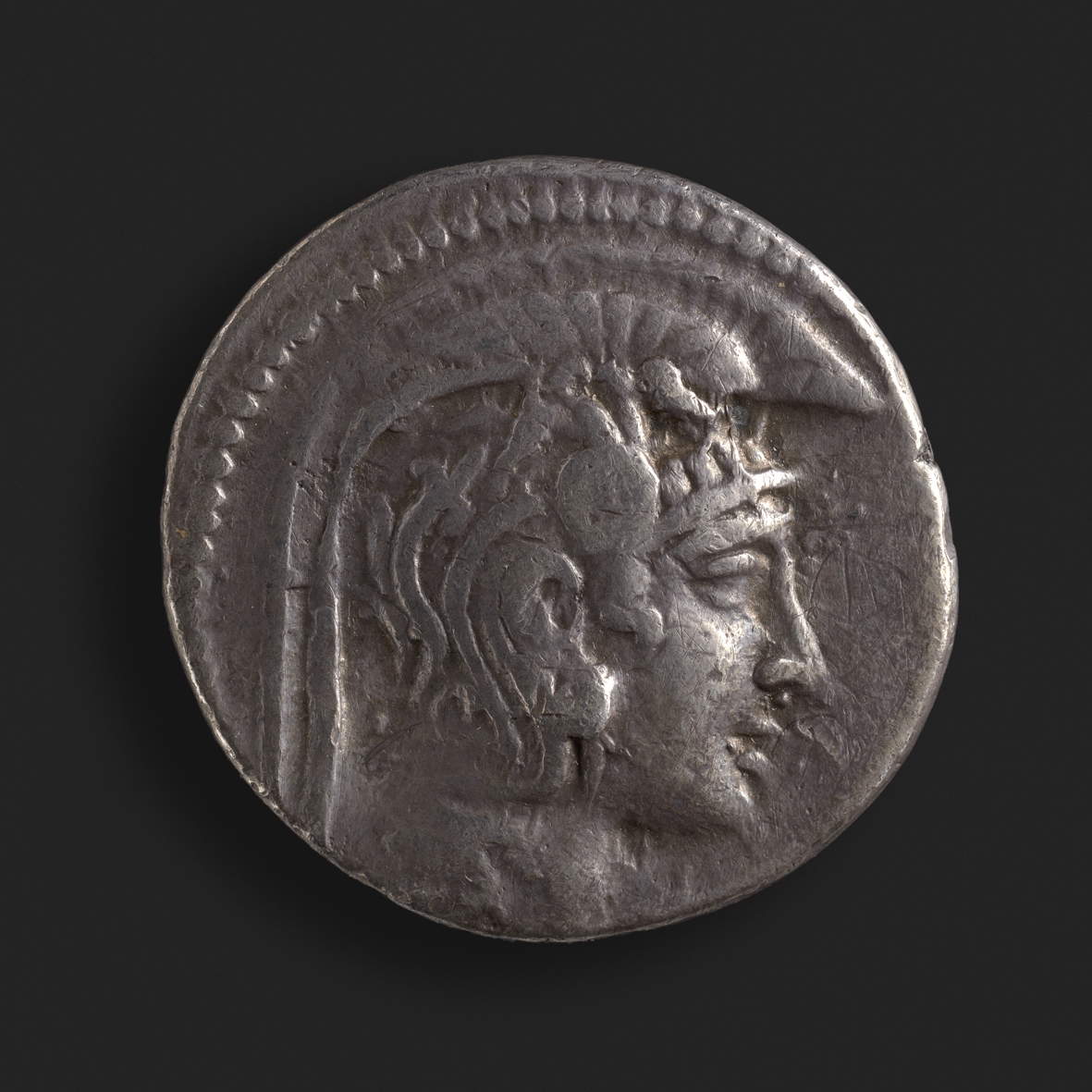
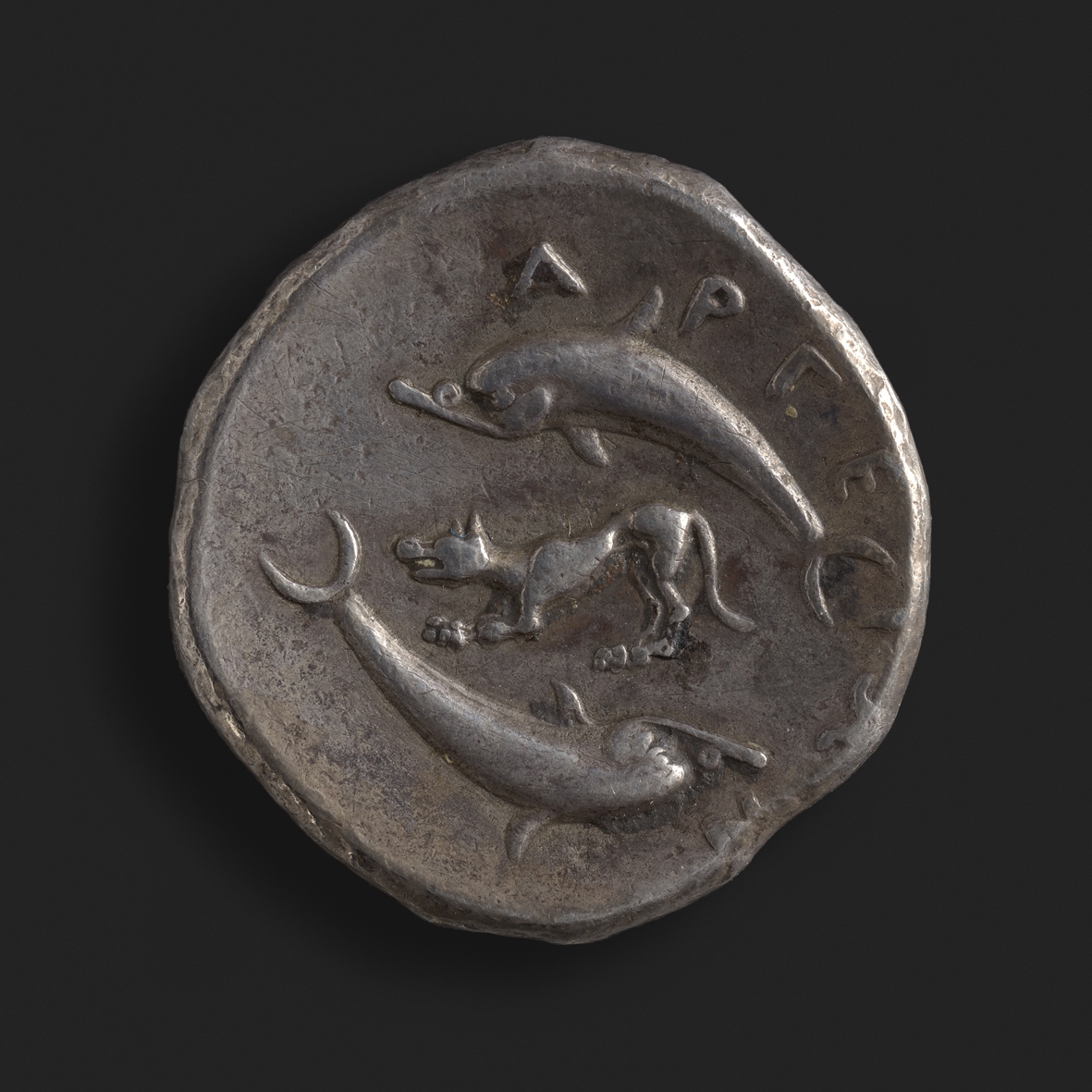
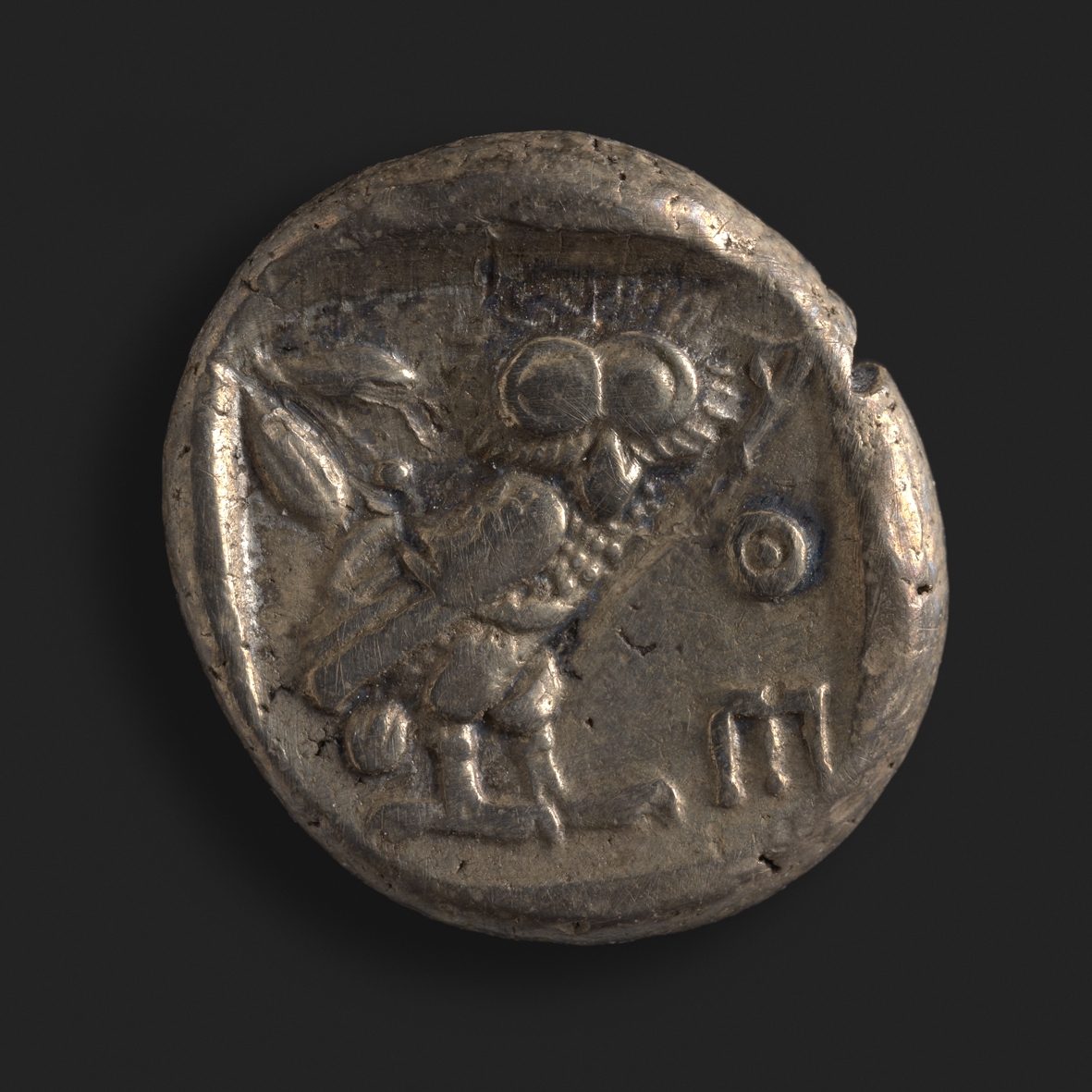
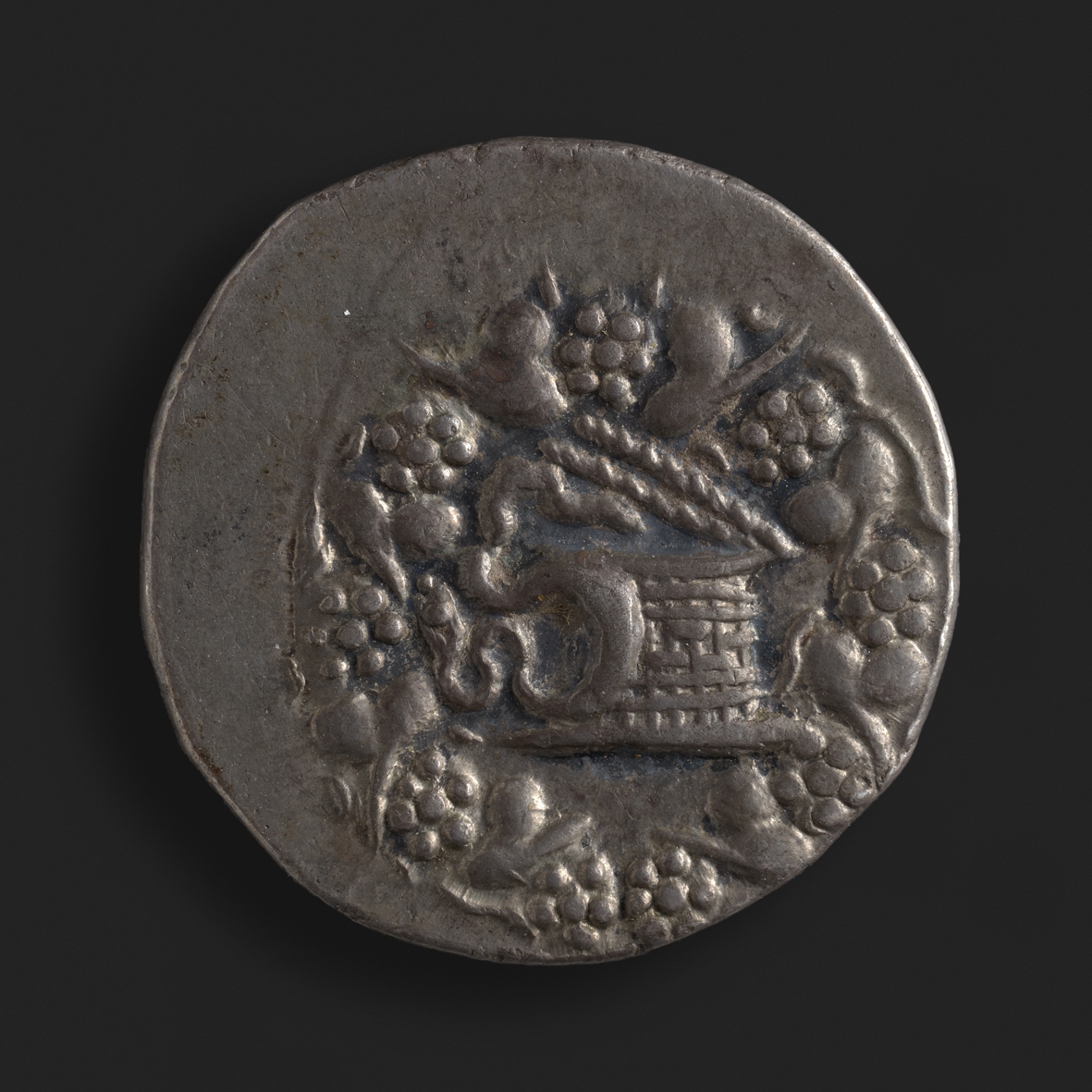
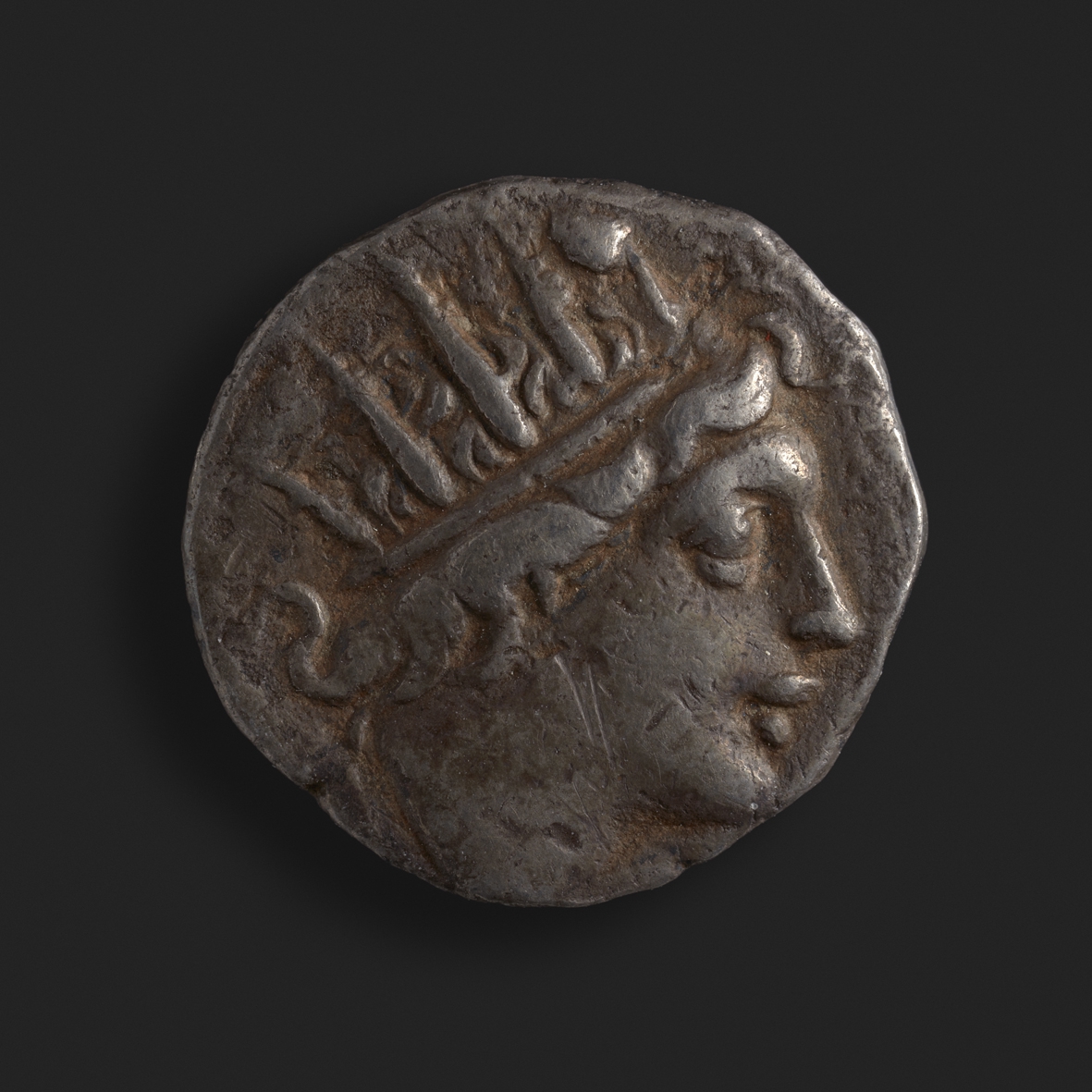
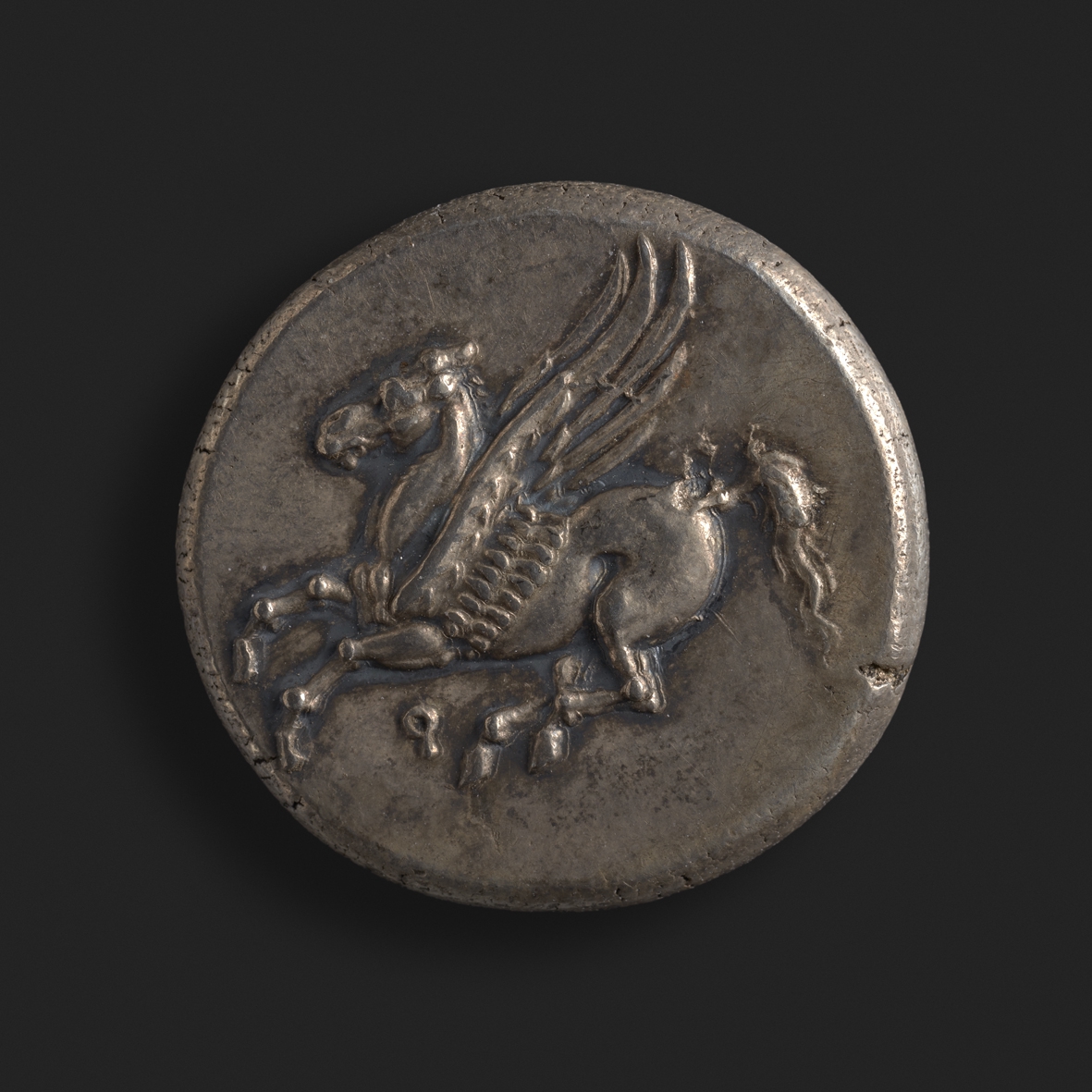
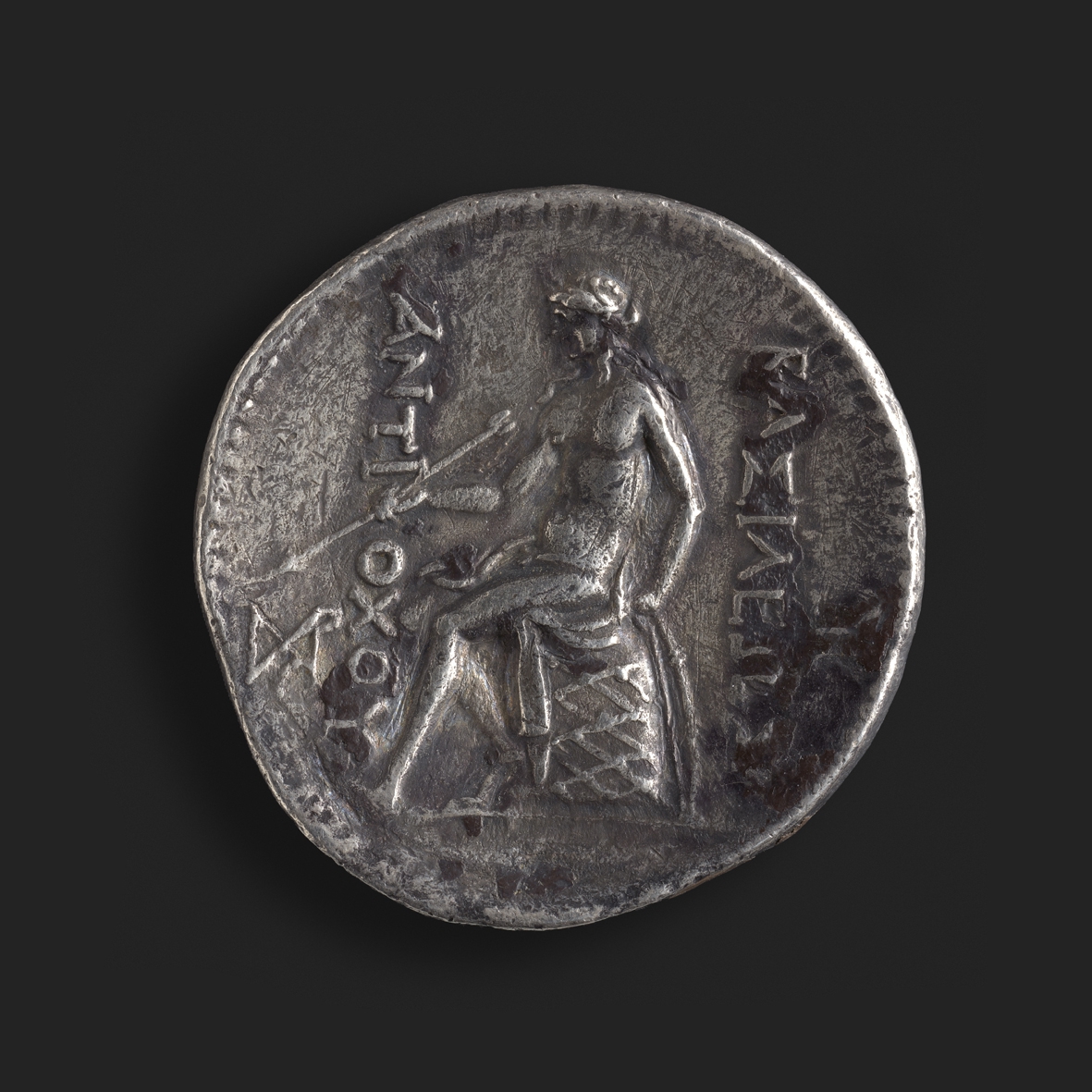
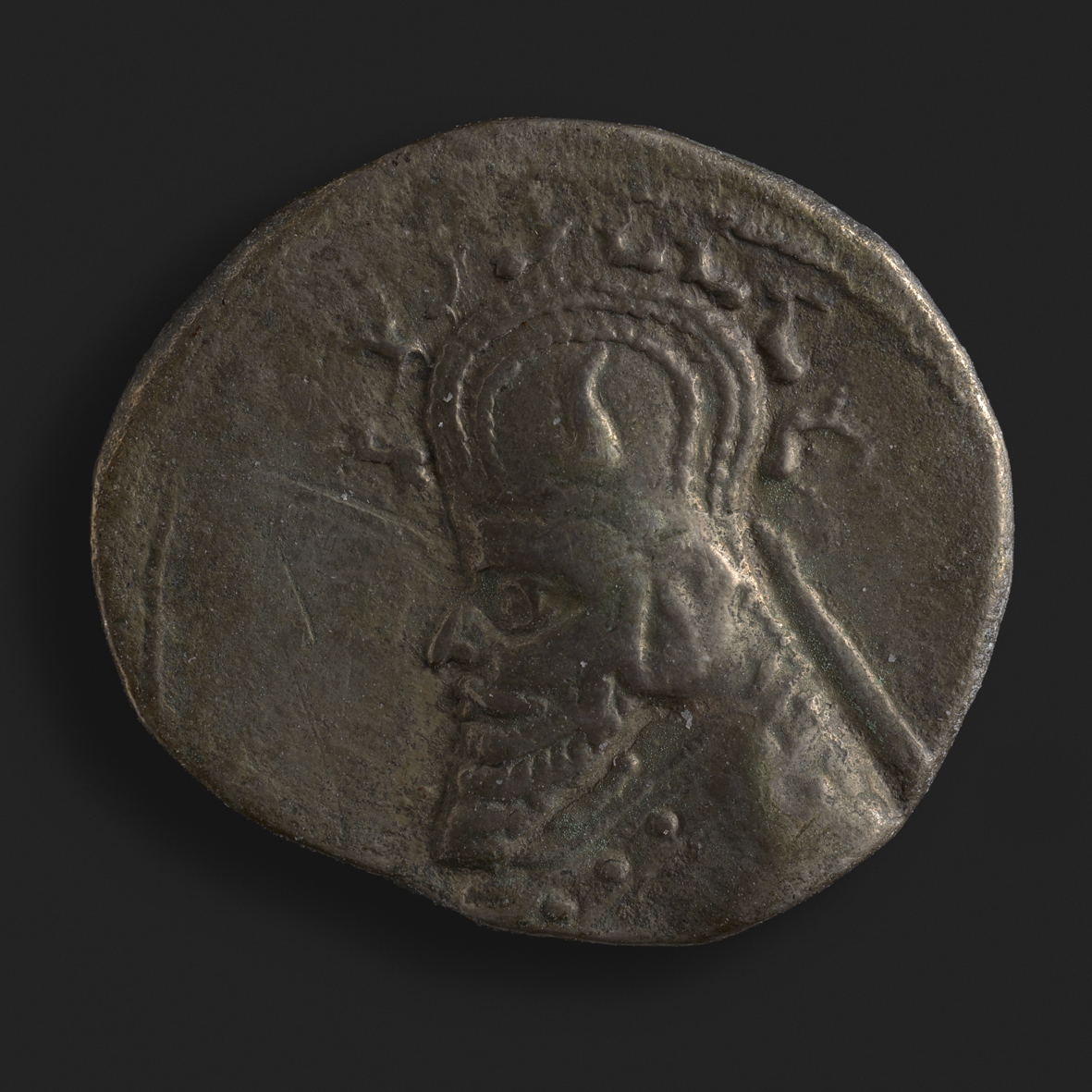
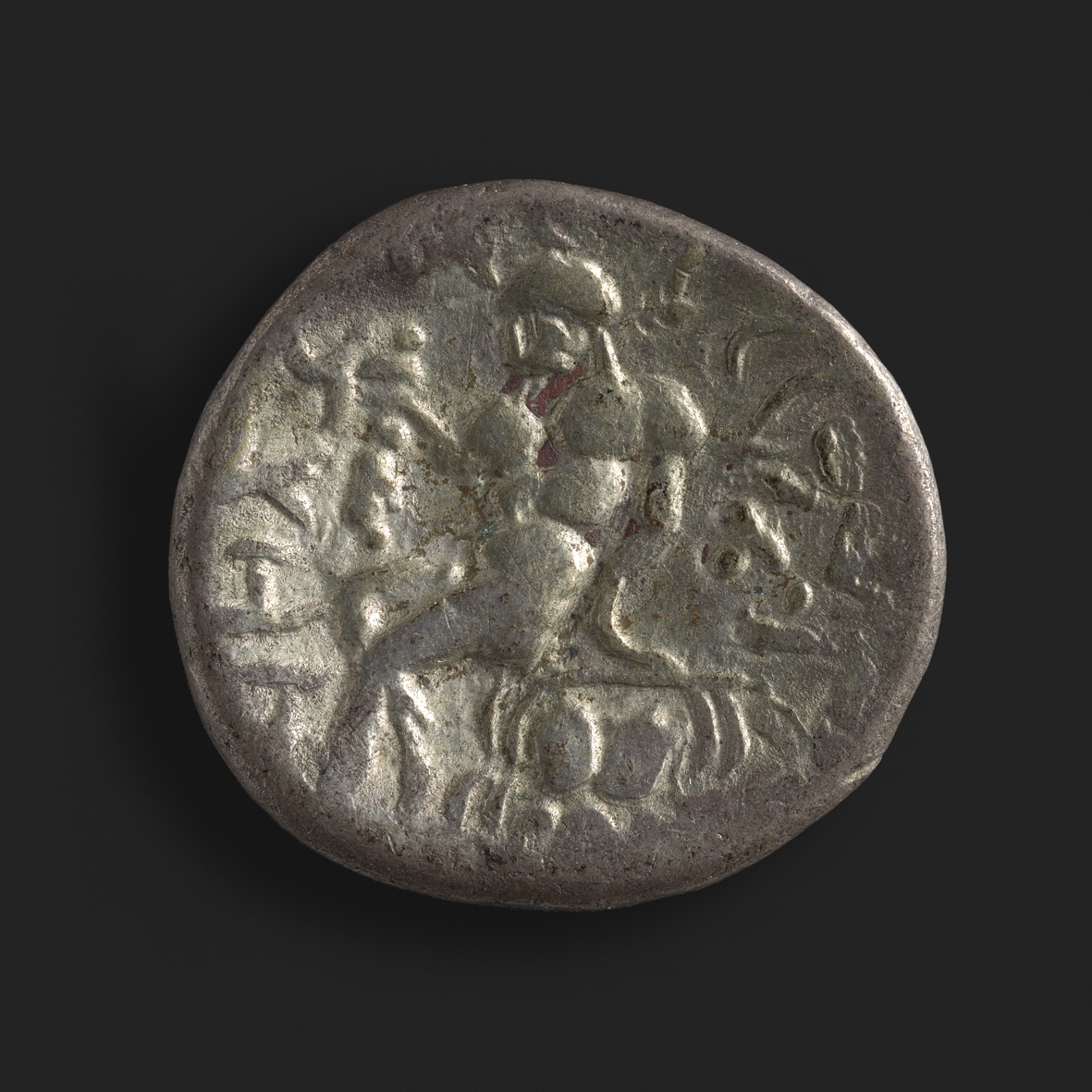
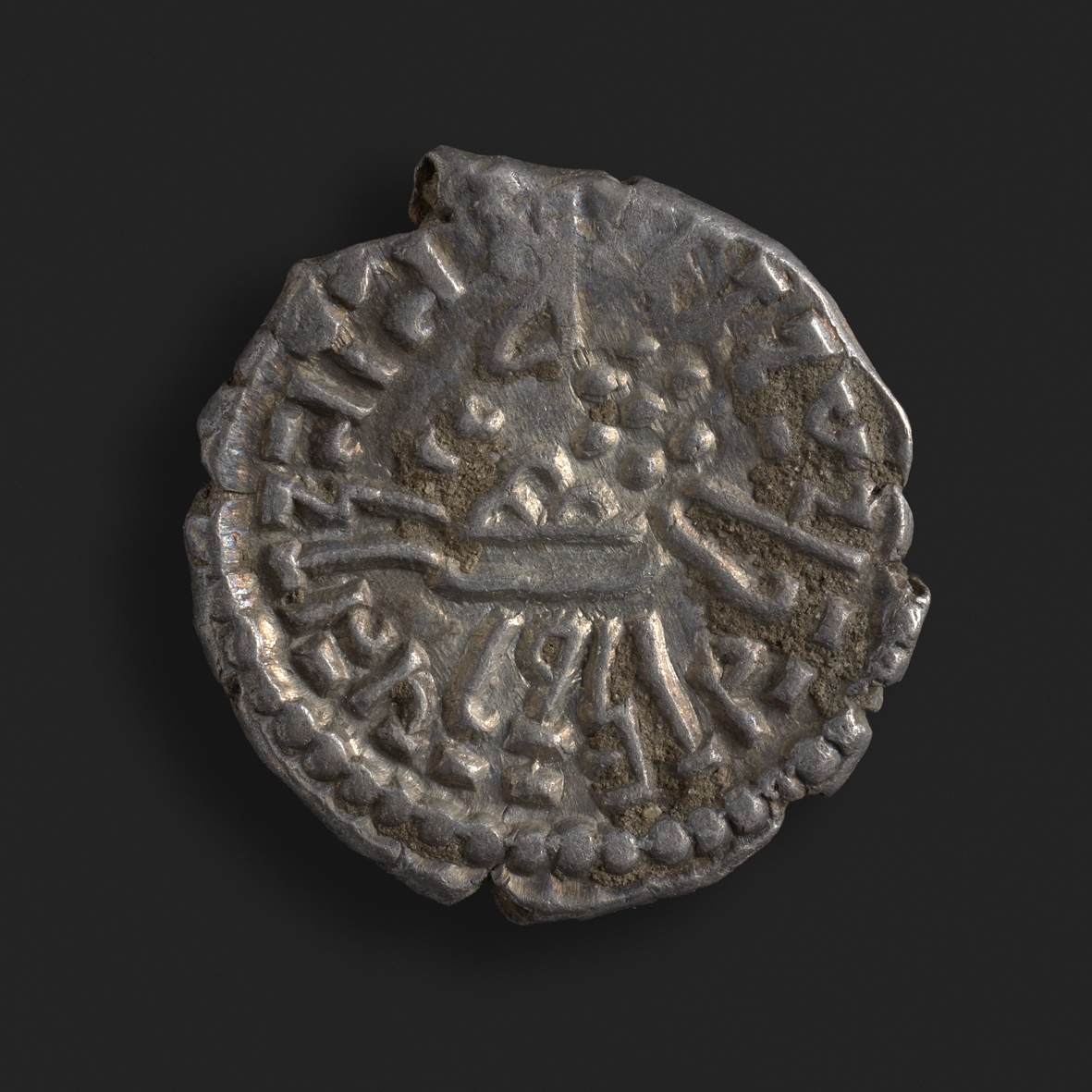
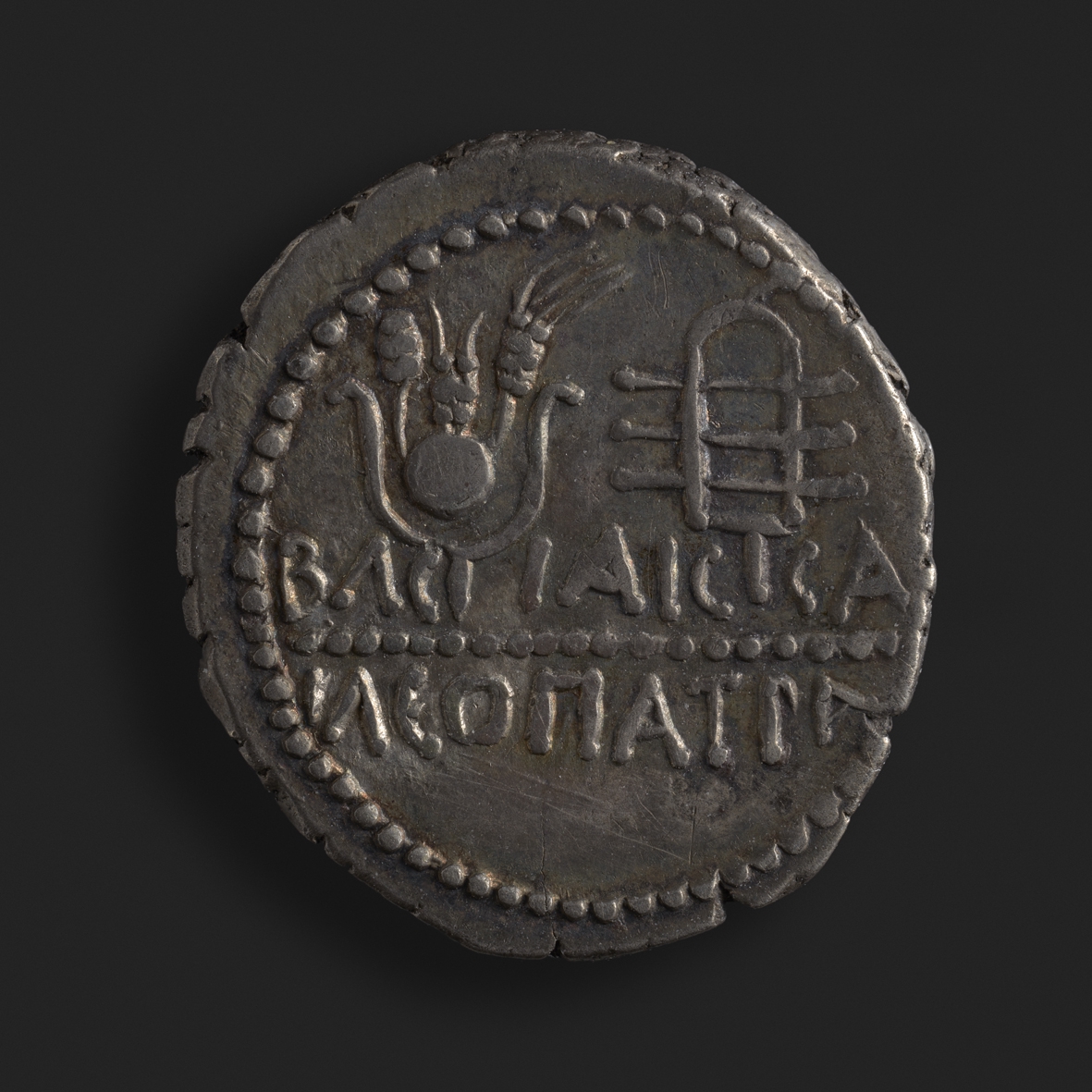
Tetrobol from Massalia
Hemidrachm from Neapolis
Tetrobol from Olynthus
Drachma of Alexander the Great from Miletus
Tetradrachm from Roman-protected Amphipolis in Macedonia
Trihemiobol from Thasos
Tetradrachm from Thasos
Drachma of Lysimachus
Stater from Thyrreium
Tetradrachm from Roman Athens
Tetradrachm from Argos
Drachma of Athens
Tetradrachm from Pergamon
Drachma from Rhodes
Stater from Corinth
Tetradrachm from Seleucia
Drachma from Parthia
Sogdian copy of a tetradrachm of Euthydemus I
Western Satraps’ “drachma” from India
Denarius of Juba II and Cleopatra Selene

Tetrobol from Massalia
The coin was struck in the Greek colony of Massalia, present-day Marseilles. The front face features the head of Artemis in profile, and the back face shows a lion and the text ΜΑΣΣΑ.
According to Strabo, an ancient Greek geographer and historian, the Phoenicians, who founded the city, had been instructed by the oracle to take Artemis of Ephesus as a guide before leaving for their journey. When they arrived, they built a temple for Artemis, and the goddess became the patron of the city. The temple became one of the most famous places of worship dedicated to Artemis in the ancient world. Because of this connection, Artemis also features in the city’s coins. The lion, on the other hand, may be related to the role of Artemis as the goddess of hunting and wild animals. Artemis has also been depicted in art with lions.

Digital collection

Hemidrachm from Neapolis
A coin struck in Neapolis, present-day Naples, with a facing gorgoneion on the front and the nymph of Neapolis on the back with her head in profile.
Neapolis was part of Magna Graecia, “Greater Greece”, which consisted of Greek settlements on the southernmost coast of Italy. Gorgoneion was a typical Greek protective symbol, which was used not only in coins, but also in mosaics in front of doors. It is also often depicted in Athena’s aegis, which, according to Homer, originally belonged to Zeus. In general, both gods were often portrayed with a gorgoneion as part of their costume. The nymph, on the other hand, is the personification of Neapolis. She is not a god, but rather represents the city of Neapolis in human form. The nymph is surrounded by the letters N E O, which refer to the place where the coin was struck.

Digital collection

Tetrobol from Olynthus
A coin from Olynthus that was struck by the Chalcidian League. Its front face features the head of Apollo in profile with a laurel wreath, and the back face shows a lyre surrounded by the text XAΛKIΔEΩN, referring to the Chalcidian League. This league was formed after several city-states broke away from the Delian League during the first phase of the Peloponnesian War, when Athens had taken on a more dominant role within the league.
The symbol of the Chalcidian League was Apollo’s lyre, which is why the god is on the front of the coin. Apart from the striking of coins, very little is known about the operations and organisation of the Chalcidian League. By the terms of the Peace of Nicias, Sparta and Athens agreed that it should be broken up, but this did not happen, probably because the peace was not final.

Digital collection

Drachma of Alexander the Great from Miletus
A coin struck during the lifetime of Alexander the Great in Miletus, with Heracles on the front and Zeus on the back. It is often difficult to distinguish between coins struck during Alexander’s lifetime and coins struck by his successors after his death in an effort to strengthen their position as rulers of their new kingdoms. The Miletus series is one of the few coins likely to have been struck during Alexander’s lifetime.
The figures depicted on the coin are strongly linked to the legend formed and built around Alexander. Even during Alexander’s reign, he was said to be the son of Zeus. Later, after Alexander’s death, this belief spread, and the Greek biographer Plutarch, among others, wrote about Alexander’s divine roots. It is also believed that, after conquering Egypt, Alexander himself said that Zeus-Ammon was his father. It is possible that this was a way of creating a picture of a new ruler suited to the local beliefs, for kingship was strongly associated with divinity in Egypt. Later on, this method was also used by Ptolemy, who became King of Egypt after Alexander’s death. On the other hand, the story of the divinity of Alexander was well-known elsewhere in the Mediterranean, and kings descended from gods were not an alien concept to the Greeks either. Heracles was an important part of the mythical history of the Argead dynasty, who, according to their own words, were descended from Caranus, a descendant of Heracles. In addition, Alexander himself was compared to Heracles in ancient sources. One of these similarities was also that both of them were sons of Zeus, at least according to the legends.

Digital collection

Tetradrachm from Roman-protected Amphipolis in Macedonia
This coin was struck in Macedonia when the kingdom was under Roman protection before it became an official province in 146 BCE. On its front face is a Macedonian shield with the head of Artemis in profile in the middle. On the back, inside a wreath of oak leaves, there is the text MAKEΔONΩN ΠPΩTHΣ with a wooden club in between. The word ΠPΩTHΣ refers to the division of territories by the Romans, in which Macedonia was divided into four parts, with Amphipolis being the first. Artemis was an important god for the Macedonians, since hunting was a popular activity and part of Macedonian culture. In Macedonia, Artemis was the patron goddess of the transition of young girls to adulthood, in the same way as Heracles Kynagidas was for young boys.

Digital collection

Trihemiobol from Thasos
The coin was struck on the island of Thasos. On its front face is a bearded satyr kneeling with a kantharos in his hand. The back face shows an amphora with the word ΘAΣIΩN around it, referring to the minting location.
Both satyrs and the kantharos are symbols associated with Dionysus, and Thasos also has a mythical connection with Dionysus. According to Aristophanes, for example, Dionysus’s lover, Staphylus, lived on Thasos, which is why Dionysus loved Thasian wine.

Digital collection

Tetradrachm from Thasos
A coin struck on the island of Thasos. The front face features the head of Dionysus in profile and the back face shows Heracles, surrounded by the words ΗΡΑΚΛΕΟΥΣ, ΘΑΣΙΩΝ and ΣΩΤΗΡΟΣ. There is a hole near the edge.
In addition to Dionysus, the cult of Heracles was strong in Thasos. There was a large temple of Heracles in the northern part of the island, and the back face of the coin probably refers to this. ΣΩΤΗΡΟΣ may refer to a place called Sotiros on the island of Thasos. This coin shows us how several gods were worshipped even on smaller islands. Even if a certain god or goddess was a special patron of the city, this did not mean that they were the only god worshipped. Heracles was generally a popular hero and god in the ancient Greek city-states. He is easily recognisable by his club and, in this case, by his name on the coin itself.

Digital collection

Drachma of Lysimachus
The drachma of Lysimachus, with the head of Heracles in profile on the front and Zeus sitting on a throne on the back, with the text ΣIMAXO on the right, probably part of the word ΛYΣIMAXOY. This is an excellent example of how Alexander’s successors used his coin styles long after his death to strengthen their positions in their new kingdoms. In this case, the text also indicates whose coin it is, which is not typical. Lysimachus was one of Alexander’s seven generals who, after the death of Alexander, divided his kingdom among themselves. Lysimachus became King of Thrace. The lion’s head on the front face of the coin may be a reference to legends of Lysimachus fighting a lion with his bare hands and winning, thus impressing Alexander.

Digital collection

Stater from Thyrreium
A stater struck in Thyrreium, with the head of a beardless Achelous in profile on the front and Apollo sitting on a throne on the back. On the right-hand side of the back face is the word ΘYPPHΩN.
Achelous was an ancient Greek god of the Achelous River, worshipped throughout Greece in various cities and considered to be the most notable of the gods of the rivers. Thyrreium was not along the river, although the island was located near its mouth, which partly shows how widely the cult of Achelous had spread.
Apollo on the back face refers to Apollo Aktios, whose temple was located in the Ambracian Gulf in the province of Acarnania, to which Thyrreium belonged. Aktios was added to the name because the temple was located in the city of Actium. Apollo was the patron god of the city, and according to Strabo, the geographer, games dedicated to the god were held there every five years.
This coin is a good example of coins that could be struck by cities that did not have any well-known special characteristics. All the characteristics refer to the province where the island was located, except for the name of the city on the back.

Digital collection

Tetradrachm from Roman Athens
An Athenian coin with Athena’s profile on the front and an owl and eagle on the back, as well as the text A KAΛΛIKPA ΘE EΠIΓENH ΣOΣANΔPOΣ, i.e. the names of the archons at the time (Callicrates, Epigenes and Sosandros). The new style of the coin’s back face can be dated to the time of the Roman conquest. Athenian coins had remained the same for a long time, but just as Macedonian coins went through change when Macedonia was under the protection of Rome, so did Athenian coins as the Roman influence increased in Athens.
One of the changes was the eagle added to the back face. It can be interpreted in different ways. The eagle was a symbol of Zeus, with which he was often depicted all over Greece, on coins and other arts. Since Zeus was Athena’s father, it is possible that the eagle is a reference to this family connection in this case. But the eagle was also a symbol of war for the Roman army. Therefore, it is possible that the addition of the eagle to the coin after the Roman conquest of Athens symbolises the presence of the Romans in the city. However, the Romans do not seem to have interfered with the Athens system of government, even though, in principle, it was part of the Roman Empire, but classified it as a free city. For example, the names of the archons were still Greek. Whatever the reason for the change, Athenian coins changed at the same time as the influence of the Romans increased on Greek territory.

Digital collection

Tetradrachm from Argos
A tetradrachm from Argos, the front face showing Hera’s face in profile with a stephane on her head. The back face features a dog between two dolphins.
In Greek mythology, the name of Hera’s giant servant was Argus Panoptes. In addition, the great temple of Heraion, one of the most important places of worship dedicated to Hera in ancient times, was located on Argos. The dog on the back is possibly a play on words relating to Homer’s Odyssey. In the story, Odysseus’s dog was called Argos. Wordplay like this was common on Greek cities’ coins. It is also possible that Argos had some connection with dogs or wolves in ancient times, but Hera has no known connection with either of them and they do not appear among the symbols that are often associated with her.

Digital collection

Drachma of Athens
A drachma from Athens, with Athena in profile wearing a helmet on the front and an owl in a recessed square on the back. There is an olive branch in the upper left corner of the square and the letters AΘE on the right. The front face of the coin is slightly skewed.
Athenian coins are different from those of other Greek cities. Usually, cities changed the style of their coins every few decades, but Athenian coins remained the same since the 6th century, despite the fact that their striking began under the tyranny started by Peisistratos. Although Athens moved to a democratic model of government after the end of the tyranny, the style of the coins was not changed. The coins remained the same until 164 BCE, when the influence of the Romans in Athens and the rest of the Greek peninsula increased.
Athena was the patron goddess of Athens. According to the myths, the city was named after Athena, who won a contest against Poseidon to be the patron of the city.
Athena’s victory was guaranteed by the olive tree she gave to the Athenians, which, thanks to the oil and fruits, proved to be more popular than the saltwater spring that Poseidon raised from the ground. This is why there is an olive branch on the back of the coin. The owl, on the other hand, is one of the animals most commonly associated with Athena. Also noteworthy is Athena’s helmet, which clearly differs from a Corinthian helmet. Since Corinth and Athens were often at war with each other because of their prominent position on the Greek mainland and their aspiration to ascend to hegemonic status, it is not surprising that the cities sought to create visually different versions of the same goddess.

Digital collection

Tetradrachm from Pergamon
A tetradrachm struck in Pergamon. The front face features a snake entering a cista, and on the back there are two snakes wrapped around each other, with the tail of the snake on the right wrapped around a rod.
A cista is a basket that is believed to be of Egyptian origin. It was used for both practical and religious purposes. In Greek mystery cults, including those dedicated to Dionysus and Demeter, snakes and cista were typical imagery. In this case, the snakes probably refer to the god of health and medicine, Asclepius, whose dedicated place of worship, Asclepeion, was located in Pergamon and was one of the most important in the ancient world. People would travel long distances to get there to be healed.

Digital collection

Drachma from Rhodes
This drachma from Rhodes features Helios in profile wearing a crown on the front, and the back shows a budding rose with a cluster of grapes and the letter P on the left, the letter O on the right and the word MAHΣ at the top.
This drachma does not follow the Attic standard. Instead, it is a plinthophoric drachma, which weighed slightly less. This was due to a monetary system reform that took place in Caria around 190 BCE, resulting in the standard weights of coins changing. The word plinthophoric comes from the Greek word plinthos (πλίνθος), which refers to the square recess on the back of the coin.
Helios was the patron god of Rhodes. After the Egyptians failed to occupy the island in the 4th century, a huge statue of Helios was erected in the city of Rhodes, known as the Colossus of Rhodes. It was one of the Seven Wonders of the Ancient World and, for example, the geographer Strabo and Roman author Pliny the Elder wrote about it in their works. The name of the island came from the ancient Greek word for rose, ῥόδον (rhodón). This is why there is a rose on the back.

Digital collection

Stater from Corinth
A Corinthian stater with Pegasus on the front. On the back is Athena wearing a Corinthian helmet and behind the helmet on the right is Artemis holding a torch.
What is interesting about Corinthian staters is that they have Pegasus on the front face instead of a portrait of a god. This is because Bellerophon, who tamed Pegasus, was born in Corinth according to the myths. Athena was worshipped throughout Greece, but in this case it may also be a reference to the myth of the taming of Pegasus since Athena helped Bellerophon in his feat. What is noteworthy about Athena’s portrait is that she is wearing a Corinthian helmet, unlike in Athenian coins, for example. This was probably intended to emphasise Athena’s connection with Corinth instead of Athens. Artemis was also worshipped in Corinth, and there was a temple dedicated to her.
The symbol Ϙ under Pegasus referred to Corinth because the original spelling of the name of the city was Ϙόρινθος. A letter of Phoenician origin, koppa remained in coins, even though it disappeared from the Greek alphabet by the 5th century.

Digital collection

Tetradrachm from Seleucia
A tetradrachm of Antiochus II from Seleucia. The front face shows the profile of a young man wearing a diadem, and the back face features Apollo sitting on the omphalos holding a bow and arrow. The back face has the text BAΣIΛEΩΣ on the right and ANTIOXOY on the left.
Antiochus II Theos was King of the Seleucid Empire in 261–246 BCE. Founded by Alexander the Great’s general Seleucos I Nicator, the Seleucids were a dynasty who ruled various parts of Persia and Syria over the next centuries. Legends were told about the founder of the dynasty that were similar to those of Alexander the Great, but the founder’s divine father was Apollo instead of Zeus. Later, the Seleucid dynasty thought they were descended from the god, which is why he was on the back of the coin.
The omphalos, on which Apollo is sitting, was a sacred stone considered to be the centre of the world, located in Delphi. The portrait on the front is possibly of Antiochus II’s father Antiochus I, but this is not certain.

Digital collection

Drachma from Parthia
A Parthian drachma with a bearded man on the front, facing left, wearing Parthian royal headgear. Above the head is text written in Parthian, in Pahlavi script. On the back, there is an archer who has turned to the right and has a bow in his hand.
Parthian coins are interesting in that, although they were partly inspired by the styles of Greek coins, mainly from Hellenistic kings, the Parthians themselves were not Greek. Since King Mithridates I, Parthia had been in closer contact with the Greeks, also commercially, but the coins were mainly identified with Persian symbolism and imagery. In this case, for example, Parthian features such as the royal headgear and the use of the Parthian language in the texts on the coin distinguish it from Greek coins. However, many of the coins also aim to connect with the Greeks. Some of the coins contain Greek text instead of Parthian text, and some rulers added the word philhellene (φιλέλλην) to their royal title, which literally meant a friend of the Greeks. However, it also made it clear that the Parthians were not Greeks, although they were friendly to them and, for example, the use of the Greek language was common in Parthia. In addition to this, the Parthian monetary system was also based on drachmas.
The style of almost all Parthian kings’ coins is exactly the same, except for slight changes in the texts. Because of this, it is almost impossible to date them. In this case, for example, the coin could have been struck by anyone from Mithridates II to Sinatruces I.

Digital collection

Sogdian copy of a tetradrachm of Euthydemus I
A Sogdian copy of a tetradrachm of Euthydemus I. On the front of the coin is a young man with a diadem on his head, looking to the right. On the back is a sitting Heracles, naked, turned left and holding a club in his right hand. He is surrounded by text in Sogdian.
Euthydemus I was the ruler of the Greco-Bactrian Kingdom from 230 to 195 BCE. Preceded by the Seleucid Empire, the kingdom was founded when Diodotus I, the satrap of Bactria, seceded from the empire and proclaimed himself King of Bactria. The easternmost of the Hellenistic kingdoms, it reached as far as Central Asia at its largest. Despite its geographical location, the Greco-Bactrian Kingdom was a Greek kingdom and its rulers were Hellenistic kings who spoke Greek and worshipped Greek gods.
Taking these factors into account, it is interesting that the texts of this coin were not written in Greek but probably in Sogdian, which was written in Syriac and Manichean script, both descended from the Aramaic alphabet. The texts of most of Euthydemus I’s coins are in Greek, and the reasons for the divergent texts of some of the coins are not known. One theory is that this was a “barbaric” copy of the tetradrachms struck by Euthydemus. Another possibility is that it was a Sogdian version of Euthydemus’s coins, for it is believed that, before his kingship, Euthydemus acted as satrap of Sogdia, which might explain the other language version of his coins.

Digital collection

Western Satraps’ “drachma” from India
A “drachma” of the Western Satraps from India, with the king’s profile on the front and a river, three hills, a crescent moon and the sun on the back, surrounded by text in Brahmi script.
The Western Satraps came to power in western and central India, after the Greco-Bactrian Kingdom, the Indo-Scythians and the Indo-Greek Kingdom. They may have been descended from the Indo-Scythians, but there is no certainty about this. It was only after most of the Hellenistic kingdoms had ceased to exist that the empire came to occupy an influential position, which, in addition to the geographical distance, explains the difference in imagery.
The Western style of the satraps’ coins is different from the other coins in the collection. The portrait of the ruler on the front face is reminiscent of the portraits in the coins of the Hellenistic kings, but with a distinct style of its own. The stylised landscape on the back is completely different from any back face found on Greek coins, as is the Brahmi script surrounding the landscape. The Indo-Greek Kingdom, which preceded the Western Satraps and was founded after the Greco-Bactrian invasions, was partly responsible for the original mixing of the styles. Greek culture and language were mixed with the regions’ own languages and cultures. The Western Satraps, who came to power after these Indo-Greek kings, followed the imagery of their predecessors and took it in their own direction. This was a way of connecting with the predecessors, in the same way that the successors of Alexander the Great adopted the coin styles he had created. This coin shows signs of Greek influence, but it was probably not an attempt to establish contact with the existing Greek kings; only a few of them were left at this time and most of them were in fact already under Roman rule.

Digital collection

Denarius of Juba II and Cleopatra Selene
A denarius of Juba II and Cleopatra Selene, with the profile of a young man wearing a diadem and the text REX IVBA on the front. The back face features the headdress of Isis on the left and a sistrum on the right. Below them is the text BACIΛICC KΛEOΠTP.
This is one of the few coins attributed to a woman along with her husband. This was probably a Roman influence since both Juba and Cleopatra grew up in Rome. Juba’s father Juba I was King of Numidia until Julius Caesar conquered his kingdom and Juba I committed suicide. His son was taken to Rome and was raised by Julius Caesar and later by Emperor Augustus. Cleopatra Selene was the daughter of Cleopatra VII, the last pharaoh of Egypt’s Ptolemaic dynasty, and Mark Antony. Cleopatra VII and Mark Antony committed suicide after losing the war against Augustus. Juba II and Cleopatra Selene were married, and Juba II was made King of Mauretania under Roman rule. Roman coins could use spouses’ names or portraits, especially later in the imperial period, unlike in the Hellenistic kingdoms. On Greek coins, the portraits of goddesses were typical, but ordinary mortal women were not portrayed.
This coin was sort of split between the couple. The front face features a possible portrait of Juba II and the name REX IVBA (King Juba), written in the Latin alphabet. The symbols on the back relate to the history of Cleopatra Selene’s family as rulers of Egypt, and the Greek name BACIΛICC KΛEOΠTP (Queen Cleopatra) refers to her Greek roots.
